I have been getting several text messages from Drew over the past day or so in response to this issue and because he is an expert in this area, I wanted him to write his thoughts on the issue. I would also encourage you to read the essay that he wrote on Accelerate when it was released.
By Drew Crumbaugh
I have been asked by your humble webmeister Eric to flesh out my disgust at this latest mastering travesty that is becoming pervasive with R.E.M.......
First though, I refer you to this: Loudness and Accelerate, An Essay.
Seems like we've been here before. 2008's Accelerate is one of the worst-mastered CD's in my collection, and yet, I think this Fables reissue tops it.
To summarize that writeup linked above, which I wrote (again at Eric's behest) in 2008, when you have a fixed-size container of music, you can't squeeze in more music without the container bursting, or warping
(distorting) the music to fit.
We live in a 16-bit world. The quick-and-dirty layman's Guidebook to Digital Audio, which someone really should sit down and write for Internet audiences, says so.
What does this mean? 16 bits of what, exactly?
Your typical CD is, essentially, an audio container. So is that iTunes music file. So is that MP3 file sat over there on the computer. Just like any container in the world made out of rigid material, the container is what it is and cannot be modified. So you have a fixed size in which to put things. (Nitpicker's corner: Joe Listener doesn't have a high-def setup with SACD/DVD-Audio inline, so we shall ignore them. Not relevant at all to our discussion.)
In digital terms, the CD audio container holds 16 bits of audio. Those bits are, ridiculously simplified, equivalent to the unit lines on the side of a measuring cup. If you have a measuring cup that holds one liter of liquid, let's say the lip of the measuring cup, 1 liter, is also 16 bits. You can't put more in there because there is only room for 16 bits worth of audio.
(Technical discussion: 16 bits translates to usable levels of "volume" i.e. sound amplitude, starting from 0 being the ceiling (loudest) and going to -16 at the quietest. Even more technical, 16 bits indicates the granularity of change levels from one volume unit to the next. Without delving into physics and digital audio theory, 16 bits is the minimum acceptable "size" of container for your average digital music. There are purists who say you can't digitally represent an analog signal accurately, which in the analog
form has no arguable constraints to granularity or volume, with only a 16-bit-wide container, but for our discussion we shall ignore them.)
What happens to the music if we try to put more than 16 bits worth of it into a 16-bit container? It doesn't fit without modification to the music, and modification, always, changes the signal. The signal is the music.
There is an acceptable level of modification because we've lived with it since the early 1980s and the onset of consumer digital audio. But as the years progressed, CDs got louder. "Why" is a discussion for another time, but they just have. And once you reach a certain point, i.e. used up all 16 bits without doing more than simply "turning up the volume knob", you have to modify the music.
Let's say we have a 16-bit-tall pail. In that pail we want to put some grasses, grasses that range from 12 to 26 bits tall. The only way these grasses will fit is by standing them up, like they grow in a garden. So we
gather up our grasses, and put them in the bucket. In order to use our pail, we *absolutely cannot* have any grass peeking over the top. It's just not possible in this world. So once we put the grass in the pail, we have to somehow make it fit - while standing up - with nothing taller than the pail's rim.
There are several ways of doing this. We can get our special gardening tool and shrink the grass, which makes every blade of grass smaller. Because our shrinking tool shrinks everything proportionally, our 26-bit-tall grass loses 10 bits of height and ends up topping out at 16 bits tall. Our 12-bit-tall grass also loses 10 bits of height, and ends up being only 2 bits tall. Everything still proportionally looks the same though, we just need a magnifying glass to see it all.
This is the least intrusive way to make digital audio fit into the 16-bit CD container. If it's too loud to fit - and remember, for our discussion, levels of "loud" equal bits - you, essentially, turn down the volume so the
loudest signal doesn't exceed 16 bits tall. Everything gets quieter, but all proportionally, and it all sounds like the original when all's said and done. The relationship between the smallest blade of grass to the largest
doesn't change. See A Visual Guide below, photo 1, for an original IRS Fables CD waveform from a section of "Driver 8".
What if we don't want to make everything, including the tiny blades of grass, smaller though? What if we just want to make the "overs", the blades of grass that are taller than our 16-bit-tall pail, fit in, while either not touching our smaller blades that already do fit, or (shudder) making the smaller blades taller so they sound louder? Remember, we can't go over the top of our 16-bit-tall pail when we're done.
The next most acceptable way to do this is a method called "limiting". Limiting is essentially what it sounds like: you "limit" the height of the grass to a fixed height. Limiting touches only the blades taller than a
level you specify, and automagically shrinks those blades down under that limit. The longest blades, or our loudest sounds, get shorter (quieter). The blades that were already below our limit are untouched, so they remain their original height (volume). What also changes, though, is the relationship between our shorter blades and our now-limited blades. They aren't as different as they were before, the taller blades are physically forced closer to the shorter blades' levels. While this can compromise the integrity of the blades of grass, or the integrity of and spatial relationship within the music, if done intelligently it can seem transparent to all but the most discerning listener. See photo 2 in A Visual Guide, below, for an example of limiting that same portion of Driver 8 to -6dB amplitude.
The least most acceptable way, or in other words the absolute worst way to make everything fit into our 16-bit container, is a method called "clipping". Like limiting, clipping affects only those blades of grass above
some pre-set limit, but rather than automagically shrinking the blades, instead our clipper takes a set of clippers and just shears off the tops. We actually lose some of our grass, and since it's been clipped off and
composted, it can never be regained. When done to audio, you visibly see (when looking at a waveform representation of the audio) a flat top effect where the upper parts of the signal were clipped off. This is what you see in the image I initially posted.
Clipping often occurs in tandem with another technique called "compression". What compression does is twofold: It stretches out - or magnifies - our smaller blades of grass, making them taller. At the same time, it reduces our taller blades, since again they can't end up taller than 16 bits. So we have the quieter getting louder, and the louder getting quieter. Our proportional relationship between the shorter blades and the taller blades disappears - they end up looking pretty damn similar. Our quiet pieces are now almost as loud as our loudest pieces, and you begin to fail to discern the difference between the two.
Most modern mastering uses the compression+limiting method, making the quiet bits louder and shrinking down the loudest bits, so you have an overall samey-samey volume across the board. See image 3 in A Visual Guide, below, for a portion of Driver 8 compressed and limited by 9dB.
With this Fables reissue, the mastering engineer used the compression+clipping method. That person raised the overall volume - within our 16-bit CD - by turning up the volume knob and taking scissors to the
overs. What does this mean to you? Simply put, you actually *hear* this clipping. The crackling you hear on some of the drum hits, the shearing you occasionally hear (and you know shearing when you hear it, I cannot think of another way to describe it) when Stipe really belts it out on some of these tracks, is the brain perceiving that there's stuff missing. What's missing is the audio that was lopped off by the clipper. Your brain turns that flat line into static, into crackling. It doesn't know what to do with stuff that should be there but isn't. See image 4 in A Visual Guide, below, for that same portion of Driver 8 compressed by 9dB and the overs clipped as they attempted to exceed the 0dB limit.
Clipping, by the way, isn't always intentional. Without getting overly technical, audio engineers aren't limited to 16-bit containers like you and I are. When working on a digital audio workstation, with all the fancy tools
at their disposal to wring the most out of those 25-year-old tapes, they simply use bigger containers. With a bigger container, usually 24 or 32 bits wide, you have more room to work in, and when you're done with your work, you can - ridiculously oversimplified - magically change the size of your container down to 16 bits. If you're not careful though, the actual shrinking-of-the-container will clip your audio contained within, because simultaneous with the container shrinking, the razor-sharp lid scythes past like a knife as it seals the 16-bit-tall container, physically cutting off everything that breaches that 16-bit ceiling. If you've not prepared your audio for the razor-sharp lid, your audio will get destroyed as the container shrinks from 32 bits to 16 bits. See image 5 in A Visual Guide, below, for that same portion of Driver 8 amplified by 9db in a larger container, and then forcibly clipped with the container-shrinking-and-knifeblade-lid result.
So maybe we shouldn't be so quick to say the engineer intentionally clipped the audio along with compressing it. They could simply have been stupid and forgot to prepare for the bit depth change from 32 to 16 bits.
Regardless of how it happened, it's absolutely NOT ACCEPTABLE to have clipping unless it's an artistic intent (and yes, there are some that do this intentionally for the distorted effect. I have no idea why.). There is
NO REASON whatsoever a properly-mastered CD (or MP3, or iTunes file, or whatever) should clip. Clipping is completely avoidable, every time. I can tolerate, begrudgingly, the modern loud mastering movement as long as it's not oppressive (see the recent Beatles remasters, or Pavement, or the Feelies). I have no tolerance for stupidity or destructive methods however. Do not waste your money on this CD. Let's campaign for a properly-mastered version - or at the very least, a non-clipping product.
-----------
A Visual Guide: (Click on the links to view larger versions of these images).
1) a portion of Driver 8 from an original IRS CD
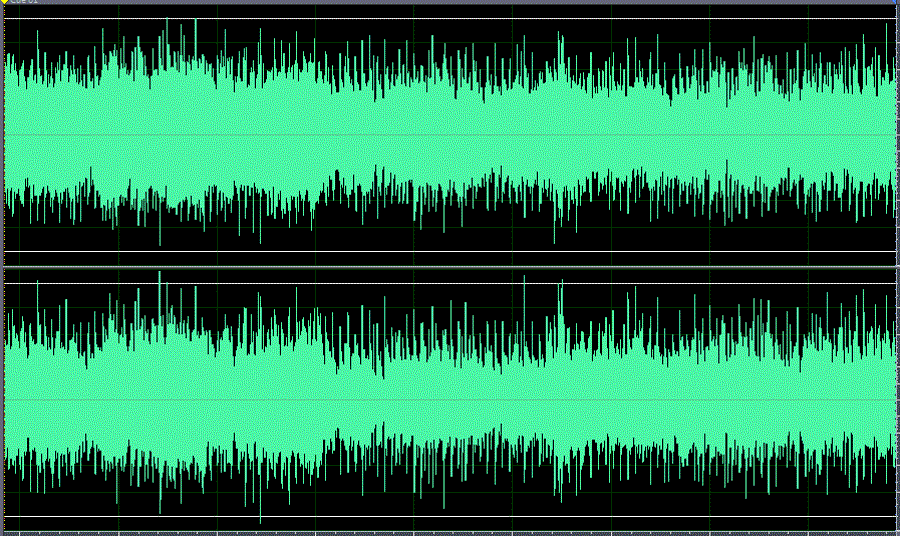
2) that same portion limited at -6dB
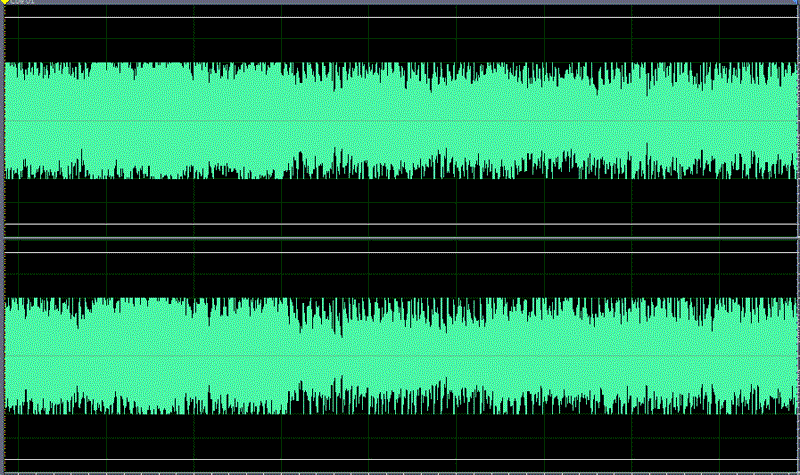
3) that same portion compressed and limited by 9dB (amplification of 9dB and
limiting the overs)

4) that same portion compressed and clipped by 9dB (amplification of 9dB
without regard for the 16-bit container)
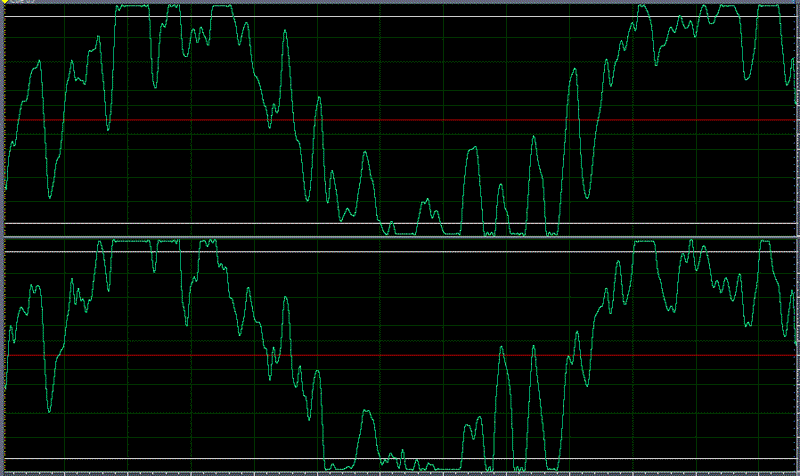
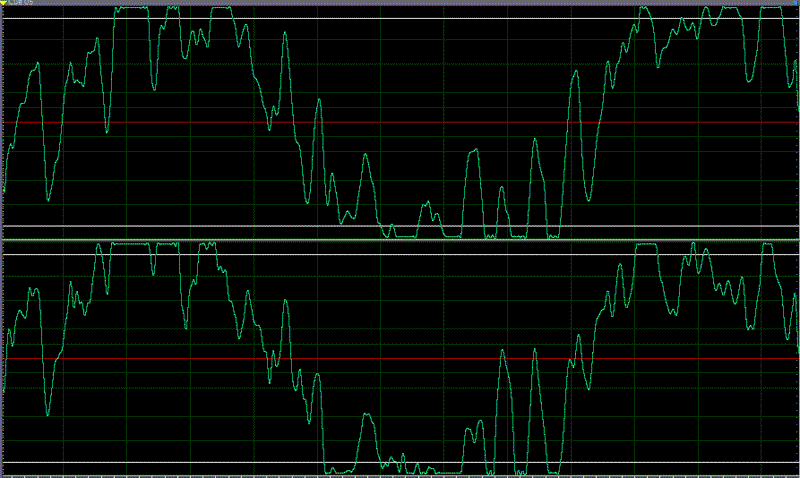
3/4/5 are close-ups of the affected signals.
The reviews of the new deluxe Fables of the Reconstruction are beginning to emerge as both Pop Matters and SoundSpike provide some early comments on the new record.
From Pop Matters:
Addressing Boyd’s concerns about the lack of a dominant element in the mix, Buck’s guitar and Mike Mills’ bass have had their volumes increased. Unfortunately, poor Bill Berry’s drums remain relegated to the background, ensuring that the whole affair remains R.E.M.’s most dated production from the 1980s.
I would also like to post for post sakes, Murmur.com's Ethan Kaplan on the new rerelease:
Some will complain that the mix is too up front, but you're missing the point. Fables is a rusty railroad spike meant to be tripped over. It was not meant to sit in the background.
And a third opinion from Drew Crumbaugh posted to the REMRing Facebook Wall:
According to the lossless rip I now have of this.... it's super brickwalled. :( Even the demos are squashed. I wouldn't call it a remix as comment#1 implies (increasing volume of Buck/Mills in the mix), rather, the squashed dynamics compress the drum sounds down deep into the overall mix. Yuck. I hear no discernable, "buy this version now" audible ... See More difference between the remastered album, and the original IRS CD, besides an obvious volume boost with brickwalled limiting. It's really yucky and the demos too have been subject to the same indignity.
Drew has also posted a photo of Driver 8 from Disc 2 of the Demos which shows obvious clipping.
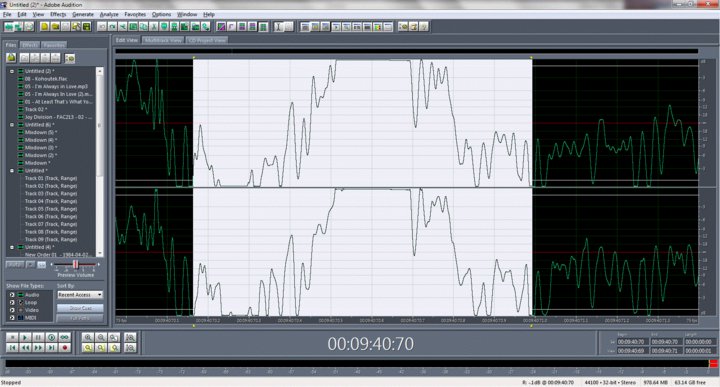
If you note the straight line in the middle of the page, this would indicate that the top of the wavelength in this example has been "Clipped" off.
And while I have not had a chance to personally listen to these myself and judge at this point, the concern that I feel early on is that remastering does not equal better. Stay Tuned!
As I sit here and mull over the streaming version of the Fables 2nd Disc, I wanted to offer some thoughts and views on Fables of the Reconstruction before it is re-released. An album that changed my life, Fables is oft forgotten in the R.E.M. canon of being an amazing rock and roll record and still holds up today as a classic.
I also thought in conjunction with my other site devoted more to general music, that this should be the inaugural entry into my “Desert Island Disc” series where I explore some of my thoughts and feelings about albums that warrant continual listens over the years.
Michael Stipe is an Asshole.
There. I said it.
I said what needed to be said. So as you sit there all uncomfortable, confused, possibly angry and wanting to throw something at me in your seat, relax and sit back while I offer some thoughts while describing in accurate detail the last 23+ years of my life.
Whenever, you have a blog devoted to one band it is a difficult sell, to try to tell the reader my love for a particular album. Why? Because how does that album differ from the other collection of songs and albums spanning 30 years? Ultimately, I am biased, but find me someone who isn’t? I am just another fanboy with another fanboy moment telling you how great something is. Truth be told, I cannot say that about every album or every song nor defend the band at great lengths for the sake of the band. Fables of the Reconstruction is an easy album to defend, however.
‘Fables of the Reconstruction’ was a slow and sometimes painful process of musical listening. It happened to be the first album that I purchased from this fabled foursome and one that continues upon the unique presence that they exhibited on their early music. If I ever create the ubiquitous “Boxed Set” of songs that mean something to me, this album or songs from it would begin the “Serious Listening Phase” of my life, when music meant something more than just Top 40 radio. And often, there are very few albums that I can actually pick up and remember the first time that I listened to it especially those that are 20+ years old.
Fables on the other hand, carries a very vivid memory. A cloudy day in mid-August on the way to Wisconsin for vacation seemed to be the perfect visionary magnet that has remained with me all these years. So, 23 years later, website and all, I sit to you writing about this album and why if you do not have it why you should.
For a 14 year old at the time listening to this album, it did not necessarily just pop out at me being pop candy. Fables is an acquired taste and particularly through a first listen, does not catch on but instead requires repeated listens and allowed to breathe like a fine wine. It’s an album that would fail today, not because it sounds dated; not at all, but for the fact that with so much music to digest, we live on gluttony and forget to taste all the flavors. This album is not going to hit you like a ton of bricks but instead focuses on the sounds of the tree limbs bending.
As the title of the album would suggest, ‘Fables of the Reconstruction” or “Reconstruction of the Fables” depending on how you read the spine, Stipe creates his own stories, his own passages from the sleepy south. Visions of Old Man Kensey catching dogs or jumping out of a casket, Brivs Mekis, the storyline behind the song “Life and How to Live It”, separating his home into two separate abodes and living in one until he tires of that one and then moving into the other. Or maybe it’s ‘Wendell Gee’ who built a trunk with Chicken Wire or Reverend Howard Finster, the subject of ‘Maps and Legends’. These are not your classic fairytale creatures but given an author’s due with sometimes discrete but dutiful expression in detail. He paints all the colors of the palette as their stories are told. This album secures them as a southern rock band but even writing this might give you the wrong idea. They are not the Allman Brothers or Skynrd but part folk song, part country, part rock and roll and a little punk thrown in there for size.
Michael Stipe is not an easy customer. This would not mean that he is difficult to deal with but rather I imagine that the requests, comments and suggestions he would offer up are without a doubt a painstaking process for everyone involved. I remember Mike Mills making a comment for example about the song “Swan Swan Hummingbird” written as “Swan Swan H” on the album cover for Lifes Rich Pageant and having a fit with that. His interviews around this time were like pulling teeth as the band mates would look over confusingly at him during comments to the point where he pretty much stops giving interviews altogether. And thus, the song meanings have always been up to the interpretation of the listener. As he paints the picture, we can often take a wrong turn or even bring something of ourselves into the storyline, focusing on the wrong line. For Stipe, this process is part that feeds him as the puzzle is laid in front of you with multiple answers.
Even as we listen to the album, there are still elements of his “mumbles” from previous efforts. However, this third effort moves him beyond the simple to the complex. Fables provides some of the most established lyric writing and compared to the rest of R.E.M.’s work, a true bold step, that questioned his wordplay or storytelling during a show. If earlier albums like the EP Chronic Town and Murmur would suggest, Michael Stipe was more a musical prop. On this album, he writes his first novel.
Welcome to the wonderful world of Michael Stipe the storyteller, playing the part of Uncle Remus relaying his own images of the south, albeit from a different perspective. Instead of focusing on racial issues, Stipe creates his own lore, people and images that provide a rich and deep history that is often absent in present day culture.
I am reminded of how difficult it was to characterize R.E.M.’s early music. Were, they progressive or folk rock or psychedelic or rock or Americana? What I think it came down to was that Michael Stipe is very visual and it was not about writing genre-based music but visual music. What he has always been able to convey is taking Bill, Mike and Peter’s music and putting a place or location to their work. While this is not totally unique in music, Stipe created places and people, especially in Fables, we often do not talk about.
Back to the “Asshole” comment. What I meant about my statement above about Michael being an asshole is that after 23 years of listening to this album, far more and longer than any album that is currently in my possession, I still am trying to figure it out. Not every mystery has been unleashed. I have not found certain “Secret Levels” where a clue might indicate a new fact about a particular song. My comment about him (Asshole) is out of sheer frustration . . .well frustration and gratitude. Our musicians can be our current philosophers; the good ones at least transcend our own meaning of life to ask questions to ourselves. It is not as simple as writing a love song about a broken heart but going beyond that. Writing about politics, religion, society, we focus on the simple in our media.
However, looking back at this album 25 years after it’s release looks at it from an entirely new viewpoint. For one, the argument that if ‘Fables’, if released today, but be chic and cool, is lost on me. By the time that Fables was released in 1985, R.E.M. were no longer the “Diaper Dandies” of the Progressive/College Rock community but had a loyal cult following. I would reluctantly point out it’s too trying in our data-driven environment to slow down enough to be willing to give it time.
That era did not have the gluttony of music that we have today and I have never looked at this album as necessarily having the components that would encourage repeated listens in today’s environment. While the album does not sound dated by any means it played a role during a certain era that needed an alternative to pop music.
Over the past 25 years is that we have a much different relationship with these songs than we did at first listen. This is both the blessing and curse of being in a rock band for so long is songs like “Feeling Gravity’s Pull”, “Driver 8” and “Wendell Gee” become part of who we are and we cannot escape that.
What is so genius about this album is how the stories and fables question our own motives and prophecies. This constant struggle between belief and common sense/technology is one whereby Stipe confronts head on using outcasts as his subjects.
Consider a song like Wendell Gee who becomes ungrounded in his pursuits via prophecy and it becomes his downfall. On the other hand, Maps and Legends says an equally engaging story about a man living in his prophecy and is laughed at by society for his own beliefs.
‘Life and How to Live It’ asks the question of whether conflict becomes such a polarizing affair through a man that splits his house in two and will live on one side of the house for awhile and then after tiring of that side will move onto the other side. When performed before the 2004 Presidential Elections I thought that the song was fitting for the political environment we live in.
Outside of the lore of the south is the fear of technology and capitalism. Green Grow the Rushes says it so perfectly in the line “Amber Waves of Gain”, whereby hard work is sacrificed for cheaper labor. Auctioneer (Another Engine), could almost be described as Rockville pt. 2 when it questions the motives of moving away for success and sacrificing love.
Where the album comes together is in the soul of the album. This is an album longing for a band that is feeling the pains of recording across the pond, conflicted over their success and stardom, getting fed into the lore of the south but also questioning it. As the band have suggested, it was a major point when the band asked themselves if they wanted to continue on this path.
Its strength is in its conviction that they are not just words written on a piece of paper for a song but the truth about an American band from the south.
This week we have seen a slow but steady release of some of the Athens Demos that will be appearing on the second disc of the 25th Anniversary Edition of Fables of the Reconstruction. Today here are three more.
(I would like to thank Christophe for finding these and posting them to Murmurs).
Feeling Gravitys Pull - Pretty Much Amazing
This was one of the newer songs in the aspect that it was never played during the shows supporting Reckoning. In that respect, we still hear a shell of a song with some insane drumming. However, it is songs like this which remind me just how important Bill Berry was to the band. Sure, Bill is an amazing drummer but there is something psychological going on currently which has pushed the drums to the back of the track and made them mostly meaningless. One of my favorites so far.
Bandwagon - Large Hearted Boy
This B-Side/Dead Letter Office classic is interesting in my opinion Michael's delivery is sorta sluggish, and lacks the pomp that he offers on the official version. Feels like the "Sleepy Athens Version". I think one of the reasons I like the official version is that he feels as if he was on a soapbox talking in that southern drawl of his with energy.
Good Advices - Fuel Friends
Still one of my favorite tracks off of Fables, (which I could probably say for the other 10). I think one of the things that is apparent on this track is about 2/3rd's in Mike's backing vocals are much more pronounced, obviously due to the recording, but at the same time something different and fun.
Lastly, by next Monday, all of these songs will be available via KCRW as both the official album and demos will be streaming there. So you will not have to read my 40 second reviews of the songs.
Although I think I posted this to the REMRing Facebook page already I have not posted it here. Here is an exclusive listen to "Throw Those Trolls Away", the previously unreleased R.E.M. song that will appear on the 25th Anniversary version of Fables of the Reconstruction.
Throw Those Trolls Away - Metromix
For those of you that have been collecting bootlegs for awhile you will know that this would appear to be a separate song that eventually morphed itself into "I Believe" which ended up on Lifes Rich Pageant.
My feeling is that this would be the track that the diehards will love to have, getting a nice clean copy of a song that was played very briefly on the tour and then scrapped. But it also shows the band again taking a piece of work and not being completely satisfied with the work and moving onto something bigger and brighter with "I Believe".
One of my fears with the 2nd Disc that is contained in the Fables Demos is that the songs will already have progressed to a point where they are not significant enough to notice any distinct changes. That being said, as a whole, I have typically enjoyed some of the latter demos that have surfaced in trading circles such as the ones of Document, Green, Out of Time and Up because we have been able to hear the songs at a much earlier point in the songs lifespan.
I think my review for the Fables 2 CD package will be based primarily off the differences between the demos and Joe Boyd's production work on the album.
At any rate, "Don't Be a Loser" and check it out!
As many are well aware the 25th Anniversary of Fables of the Reconstruction is going to be released in July and already a couple tracks have hit the internet. The all-important tracks of course is the second disc which consists of demos of Fables tracks the band recorded in Athens before departing for England to record the album with Joe Boyd.
As you would expect the early tracks are in some cases a bit more rough around the edges but not so rough as to be completely unique to the finished Fables album. Many of the Fables tracks had been performed live and had become staples of their set up to this point. So where the differences I would expect would lie would be on those tracks which are still in their developmental stages.
So far a couple tracks have made their way online.
Auctioneer (Another Engine) - Consequence of Sound
At this point my favorite of the Fables demos although I cannot put my finger on why I appreciate the track so much. It has a much different feel than the version on the album which is almost R.E.M. turning the song into a punk hit.
Can't Get There From Here - Entertainment Weekly
I have appreciated the southern drawl of Michael's voice, however, the song is still in its early stages. I think this is one song that has always felt a bit "Dated" to me on Fables, so this version might be something that I could appreciate.
Driver 8 - Rolling Stone
Unfortunately, for the Fables tracks this happens to be the one track that entered the live sets pretty early on the live shows supporting Reckoning. Thus, the song feels pretty finished by the time this "Demo" is released.
Old Man Kensey - Fashion.ie
(At this point, the track that is listed is the studio version of Old Man Kensey however, if someone catches their mistake they might correct it. The flub however, is nice to see because it reminds me back to the bootleg days when shows and songs on 'Official' Bootlegs would be mislabled, sometimes on purpose. I wonder if this is the case here!)
I will admit to listening to Fables a couple times today with the announcement of the Fables reissue. Of course, I have some feelings regarding this announcement and the subsequent “Extra Material” that is on the second disc. However, for the time being we can contemplate the release.
The album, due out on July 13th will offer both the original remastered album plus a second CD of Demos that were recorded in Athens prior to their recording sessions in England with Joe Boyd.
CD1 (original album):
'Feeling Gravity's Pull'
'Maps and Legends'
'Driver 8'
'Life And How To Live It'
'Old Man Kensey'
'Can't Get There From Here'
'Green Grow The Rushes'
'Kohoutek'
'Auctioneer (Another Engine)'
'Good Advices'
'Wendell Gee'
CD2 (The Athens Demos):
'Auctioneer (Another Engine)'
'Bandwagon'
'Can't Get There From Here'
'Driver 8'
'Feeling Gravity's Pull'
'Good Advices'
'Green Grow The Rushes'
'Hyena'
'Kohoutek'
'Life And How To Live It'
'Maps and Legends'
'Old Man Kensey'
'Throw Those Trolls Away'
'Wendell Gee'
On this very special day of days I do have some unfinished business before it strikes 12 o’clock.
First off, a very happy 50th to Kathleen O’Brien (KO). Her role in the “R.E.M. Saga” is well documented and continued happiness, health and prosperity to her and her family.
There is another band that made it’s debut on April 5th as well and were there that fateful day playing before R.E.M. Their name is the The Side Effects. The Side Effects, included Paul Butchart on Drums, Kit Swartz on guitar and Jimmy Ellison on Bass. Their role in the R.E.M. story is equally as intriguing as Paul and Jimmy Ellison were originally going to play with Peter Buck and Michael Stipe before the formation of R.E.M. but never showed up to practice, according to Peter Buck.
Paul Butchart has become a bit of an Athens Music Historian himself, giving tours, and providing in-depth insight into the time and period of this explosion of the Athens sound. I would unequivocally say that Paul should write his own memoirs of this period as it would be an instant buy not just for R.E.M. fans but for music fans in general wanting a more complete understanding of this period of music.
With this birthday celebration there was a posting of a show that the Side Effects had taped thanks to Chris Rasmussen who made a copy and the late Randy Bewley of Pylon who gave a copy of this to Paul. The show was from May 16, 1980 at the 40 Watt Club, and according to Paul, is “most likely is the same set played at the Church on April 5, 1980.” To listen click here.
Fellow REMringer Martine Hollander has also posted some videos from the REM 30 event at the Melting Pot in Athens, Georgia. The video below is Mitch Easter performing ‘Stumble’, however, I would suggest you try stumbling through all of Martine’s videos from this event. I guess I had to feature this song as it happens to be one of my favorites, plus I was listening to an amazing boot version of this song today that R.E.M. played at Merlin's in Madison in 1982.
Finally, I would like to conclude with a very special nugget that I found on the REMring Facebook page thanks to David Ersmarker. WOUG was hosting a 30th anniversary special of R.E.M. songs and they provided the world premiere of ‘Throw Those Trolls Away’ or more commonly known as “When I Was Young”.
For those that have heard of neither of those songs, “When I Was Young” was a very early rendition of what would later become ‘I Believe’ which was featured on ‘Lifes Rich Pageant’. This would appear to be a very early demo during the Fables sessions and my understanding is that it will be released on the upcoming 25th Anniversary issue of ‘Fables of the Reconstruction’. This should pique the interests of some fans as to the content of this package considering that this is not a live track but a demo and so we will have to wait and see what the rest of the package will look like.
I guess now that the official title is ‘Throw Those Trolls Away’ it would be best to start referring to that as the title from now on. The song was performed very early in the Fables tour performed and quickly abandoned. In fact, I think it was only known to have been played a total of 3 times.
While this demo is somewhat difficult to make out what Michael Stipe is singing, if you compare this songs lyrics to ‘I Believe’ you will notice some very familiar phrases being uttered.
In terms of the decision to scrap this song and rewrite much of it for ‘I Believe’, in my opinion it was the right decision. ‘I Believe’ is an instant classic in my eyes and this is for better or worse, just an early working of a song that just didn’t pass off as something special. At the same time, the very fact that it is being released should be something to look forward in the coming months with the Fables rerelease. You can enjoy the song here. (Note: That there is no guarantee this link will remain active).
Thanks to everyone above and so many more for making R.E.M.'s 30th a very special occasion. Even if you chose to put on some tunes and reflected on this moment, part of the fun is not just dissected the band, in many cases we begin to dissect our own lives and the amount of fulfillment they have provided to us via their music.
If you have been following the amount of shows that have been posted to Dime recently you will know that several shows from 1984 have been added to the site, thanks mostly to the legendary Henry Race who is trying to get into heaven by preaching the idea of sharing.
Hank, got in touch with one lucky fan Paul Gallagher who was so happy to see an awesome copy of the show in question (December 4, 1984, SFX Centre, Dublin, Ireland) that he decided to share with Hank some photos he took from that night.
Thanks to Paul for his willingness to share as well as Hank!

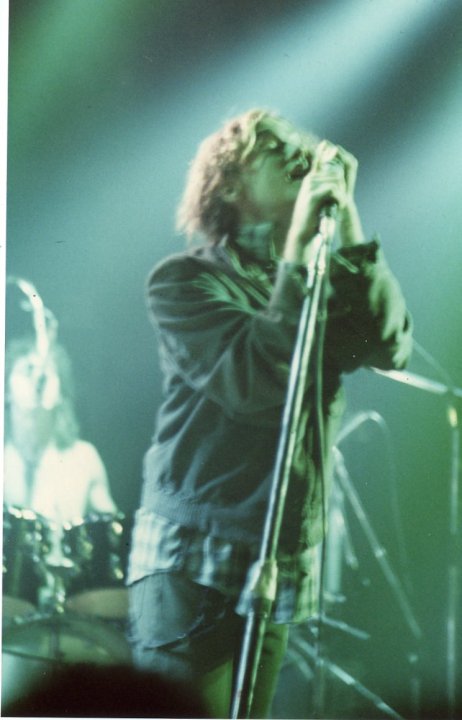

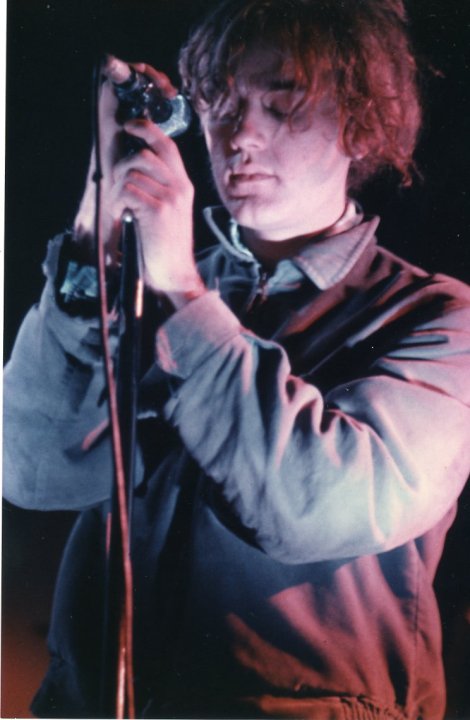

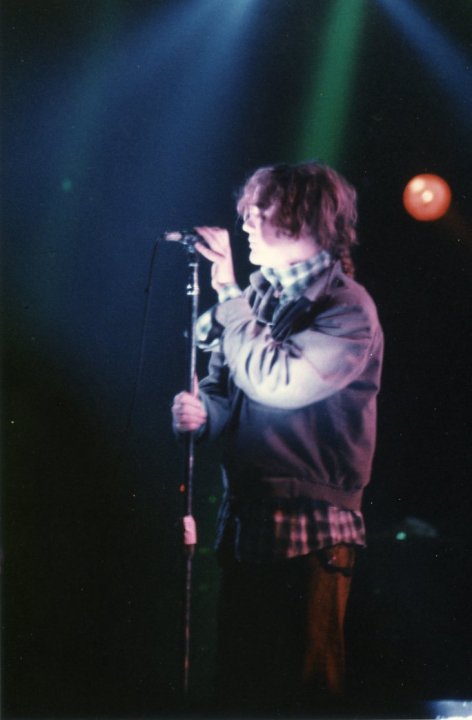
Thought I would get into the 30th Anniversary Festivities and post a podcast with yours truly playing some of the early tunes and chatting it up with myself.
So sit back and relax to my sandpaper voice as I lull you all to sleep, Rapid Eye Movement style.
Seriously, this podcast is done completely from recordings from 1980 their inaugural year as a band. What I try to examine is the very premise that even at their infancy that R.E.M. had the talent as well as the gumption to be an amazing act.